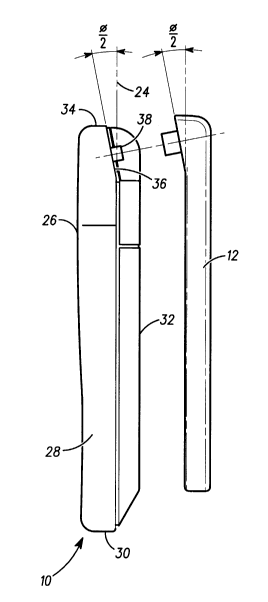Une partie des informations de ce site Web a été fournie par des sources externes. Le gouvernement du Canada n'assume aucune responsabilité concernant la précision, l'actualité ou la fiabilité des informations fournies par les sources externes. Les utilisateurs qui désirent employer cette information devraient consulter directement la source des informations. Le contenu fourni par les sources externes n'est pas assujetti aux exigences sur les langues officielles, la protection des renseignements personnels et l'accessibilité.
L'apparition de différences dans le texte et l'image des Revendications et de l'Abrégé dépend du moment auquel le document est publié. Les textes des Revendications et de l'Abrégé sont affichés :
| (12) Brevet: | (11) CA 2153380 |
|---|---|
| (54) Titre français: | DISPOSITIF D'ORIENTATION D'ANTENNE |
| (54) Titre anglais: | ANTENNA POSITIONING APPARATUS |
| Statut: | Réputé périmé |
| (51) Classification internationale des brevets (CIB): |
|
|---|---|
| (72) Inventeurs : |
|
| (73) Titulaires : |
|
| (71) Demandeurs : | |
| (74) Agent: | GOWLING WLG (CANADA) LLP |
| (74) Co-agent: | |
| (45) Délivré: | 1998-02-24 |
| (22) Date de dépôt: | 1995-07-06 |
| (41) Mise à la disponibilité du public: | 1996-01-26 |
| Requête d'examen: | 1995-07-06 |
| Licence disponible: | S.O. |
| (25) Langue des documents déposés: | Anglais |
| Traité de coopération en matière de brevets (PCT): | Non |
|---|
| (30) Données de priorité de la demande: | ||||||
|---|---|---|---|---|---|---|
|
Un radiotéléphone utilisé dans un système radiotéléphonique par satellite est doté d'une antenne (12) à gain hémisphérique (14). Comme un satellite (18) peut se trouver n'importe où dans le ciel, le gain d'antenne (14) doit être aligné avec l'hémisphère situé au-dessus de l'utilisateur. Pour ce faire, on utilise un appareil de positionnement d'antenne, comprenant l'antenne (12) ayant une surface de contact en coin (42) fixée à une surface d'attache (36) au moyen d'une goupille (38) et d'une douille (44). La surface d'attache (36) est inclinée par rapport à un plan (24) défini par l'avant (26) du radiotéléphone (10). La combinaison de la surface de contact en coin (42) et de la surface d'attache inclinée (36) positionne l'antenne (12) à un angle ? par rapport au plan de référence (24) lorsque l'antenne est en position active. Par conséquent, l'antenne (12) est orientée à la verticale lors d'un usage normal.
A radiotelephone, used in a satellite radiotelephone system, has an
antenna (12) with a hemispherical gain pattern (14). Since a satellite (18)
can be anywhere in the sky the antenna gain pattern (14) needs to be
aligned with the hemisphere above the user. This is accomplished with
an antenna positioning apparatus, comprising the antenna (12) having a
wedge shaped mating surface (42) affixed to an attaching surface (36) by a
pin (38) and socket (44). The attaching surface (36) slopes downward from
a plane (24) defined by a front face (26) of the radiotelephone (10). The
combination of the wedge shaped mating surface (42) and the downward
sloping attaching surface (36) positions the antenna (12) at an angle ? from
the plane (24) when the antenna is in the active position. As a result the
antenna (12) is vertically oriented when held by the user during normal
use.
Note : Les revendications sont présentées dans la langue officielle dans laquelle elles ont été soumises.
Note : Les descriptions sont présentées dans la langue officielle dans laquelle elles ont été soumises.

Pour une meilleure compréhension de l'état de la demande ou brevet qui figure sur cette page, la rubrique Mise en garde , et les descriptions de Brevet , États administratifs , Taxes périodiques et Historique des paiements devraient être consultées.
| Titre | Date |
|---|---|
| Date de délivrance prévu | 1998-02-24 |
| (22) Dépôt | 1995-07-06 |
| Requête d'examen | 1995-07-06 |
| (41) Mise à la disponibilité du public | 1996-01-26 |
| (45) Délivré | 1998-02-24 |
| Réputé périmé | 2002-07-08 |
Il n'y a pas d'historique d'abandonnement
| Type de taxes | Anniversaire | Échéance | Montant payé | Date payée |
|---|---|---|---|---|
| Le dépôt d'une demande de brevet | 0,00 $ | 1995-07-06 | ||
| Enregistrement de documents | 0,00 $ | 1995-09-21 | ||
| Taxe de maintien en état - Demande - nouvelle loi | 2 | 1997-07-07 | 100,00 $ | 1997-06-26 |
| Taxe finale | 300,00 $ | 1997-11-14 | ||
| Taxe de maintien en état - brevet - nouvelle loi | 3 | 1998-07-06 | 100,00 $ | 1998-06-17 |
| Taxe de maintien en état - brevet - nouvelle loi | 4 | 1999-07-06 | 100,00 $ | 1999-06-16 |
| Taxe de maintien en état - brevet - nouvelle loi | 5 | 2000-07-06 | 150,00 $ | 2000-06-19 |
Les titulaires actuels et antérieures au dossier sont affichés en ordre alphabétique.
| Titulaires actuels au dossier |
|---|
| MOTOROLA, INC. |
| Titulaires antérieures au dossier |
|---|
| SEITZ, MARTIN VICTOR |